
Chiricahua National Monument
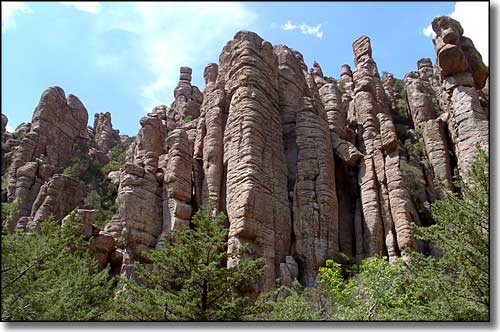
Stone columns at Chiricahua National Monument
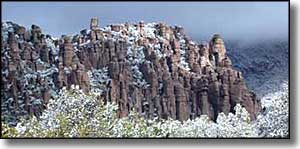
Chiricahua National Monument is in southeastern Arizona. This is a rugged mountainous area full of imposing rock spires. These rock spires are what's left after 27 million years of erosion working on layers of ash deposited by the Turkey Creek Volcano.
Chiricahua National Monument includes 11,985 acres in a "sky island": a 20-mile-by-40-mile inactive volcanic mountain range surrounded by large desert grasslands. There is an 8-mile paved scenic drive through the property wih another 18 miles of developed hiking trails. 87% of the monument has been designated as wilderness in order to preserve and protect this wild and wondrous countryside.
The Chiricahua Mountains are part of the Mexican Highlands region of the Basin and Range Biogeographical Province. The mountains present a dramatic rise from the desert floor to more than 9,000', peaking in a series of jagged, volcano-looking summits. The northern end of the mountain range (where Chiricahua National Monument is) is an area of enormous biodiversity and wild geology. The Apache name for this area translates as "The Land of Standing Rocks."
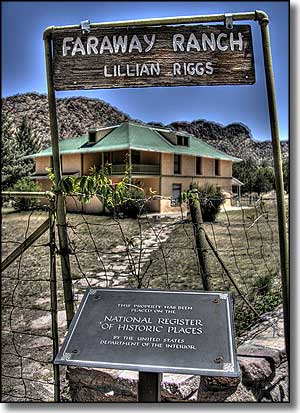
Chiricahua National Monument is at a biological crossroads. This is where the Chihuahuan and Sonoran Deserts meet and where the Sierra Madres and the Rocky Mountains converge. The monument contains 5 major drainages that support heavy forestation in these deep canyons. You'll find Engelmann spruce and Ponderosa pine rising above Soap tree yuccas in some areas. In other areas you'll find Douglas and white fir, Arizona cypress and Chihuahua pine standing over clumps of prickly pear and cane cholla. Living in these woodlands you'll find white-tailed deer, javelina, black bear, mountain lion, bobcat, grey fox, coatimundi, and more than 300 species of birds.
Most folks who visit Chiricahua National Monument make the visitor center their first stop. Depending on how much time you have to spend, there are a number of places to go from there. The 8-mile scenic drive sees a significant amount of the monument's traffic but does not allow RV's or trailers longer than 29 feet. There are several scenic overviews and some excellent loops and other hikes.
Within the boundaries of the national monument are shallow caves, mountain formations, ground faults, lava flows, and the Turkey Creek Caldera. A danger to be aware of is the rock pinnacles and spires: some of them rise hundreds of feet in the air but are balanced on a base that is smaller than the body of the rock. While a lot of them look like a good breeze will blow them over, most of those with names were named by members of the CCC back in the 1930's.
There is also the Faraway Ranch Historic District: Faraway Ranch was first settled in the late 1880's by a Swedish immigrant couple: Neil and Emma Erickson. Their simple homestead in Bonita Canyon evolved over the years into a busy guest ranch that was in operation from 1917 to 1972. You can tour the property on your own but tours of the house must be with an official guide.
Before you come to visit check your gas gauge: the nearest gas is 27 miles to the southwest or 37 miles to the northwest. There are also no vending machines at the monument so you'll want to bring your own food, snacks and drinks. March and April are the busiest months while summer can see the monument almost devoid of people.
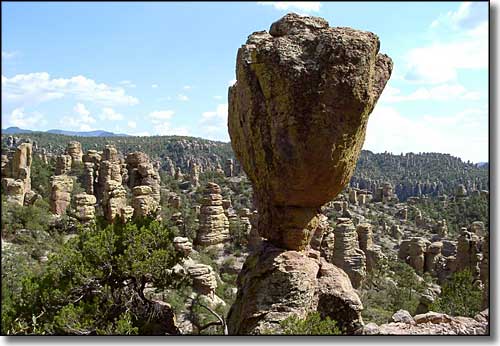
A balanced rock at Chiricahua National Monument

Map of Chiricahua National Monument
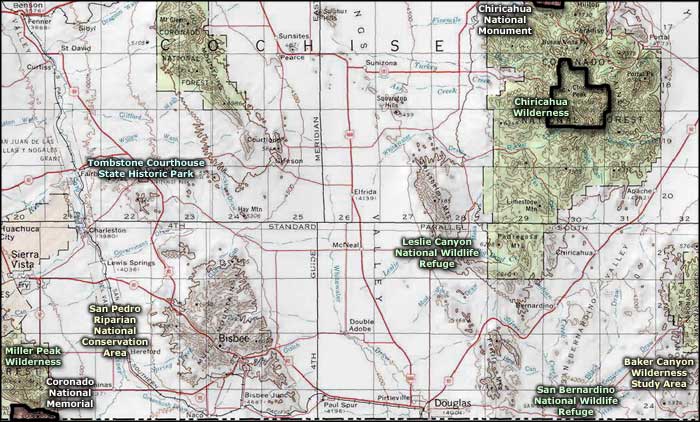
Chiricahua National Monument area map
